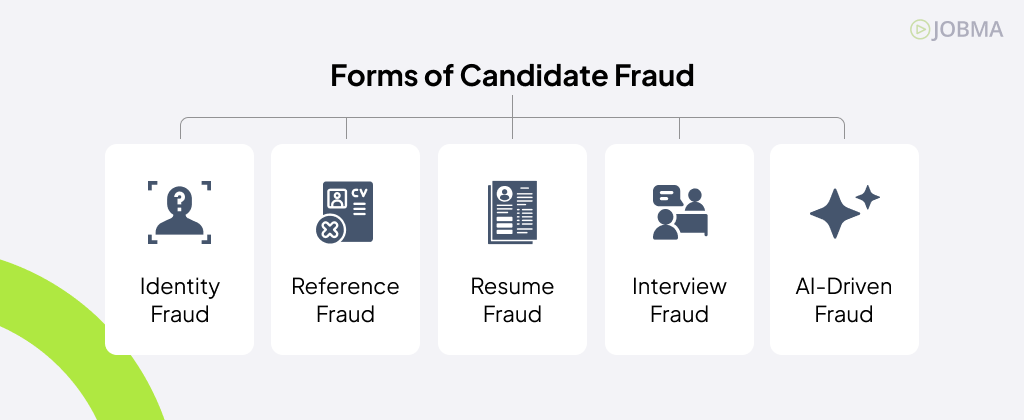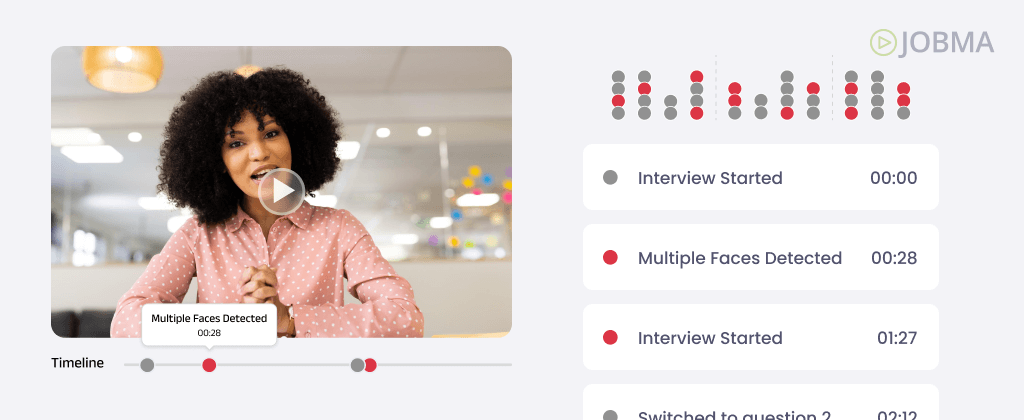Candidate Fraud in Hiring: How to Detect & Prevent It
Online hiring opens the door to more efficient and scalable recruitment. It enables employers to tap into broader talent pools and accelerate the hiring timeline. AI has become an accelerator in today’s hiring, transforming how quickly and effectively roles can be filled. It automates key stages like sourcing, screening, and initial assessments, helping teams handle more candidates in less time. But with this flexibility comes a new set of challenges that hiring teams need to address thoughtfully.
One such challenge involves ensuring alignment between what candidates present during the application process and the skills or experiences they bring to the role, and verifying candidate authenticity.

Candidate fraud is complex and can be tricky to flag. It refers to deliberate misrepresentation by applicants during the hiring process, and it’s growing more sophisticated with advancements in technology. With thoughtful systems, policy alignment, and the right tools, hiring teams can stay ahead of fraud risks without compromising the efficiency and integrity of their recruitment strategy.
In this guide, we explore what candidate fraud looks like and what hiring teams can do to minimize exposure and maintain a trustworthy recruitment pipeline.
Understanding the Threat: What is Candidate Fraud?
Candidate fraud refers to instances where applicants provide misleading or inaccurate information during the hiring process, intentionally or otherwise, that can impact hiring decisions. This goes beyond minor resume tweaks. Candidates are increasingly relying on AI to help craft applications, optimize resumes, or mass-apply to multiple jobs in a short time. These behaviors, though not always malicious, can lead to application inconsistencies that complicate fair hiring.
Examples include:
- Exaggerated job titles that may not reflect the actual role responsibilities.
- Unverifiable work experience and skills.
- Qualifications that may be fabricated to meet the requirements of the job.
In some cases, candidates may outsource technical interviews or assessments, posing risks of identity fraud. When this is paired with deepfake hiring risks, such as manipulated video or audio content, it becomes even harder for employers to distinguish between genuine and inauthentic candidates.
The growing use of AI in hiring fraud means organizations must adapt. Relying solely on LinkedIn profiles, polished résumés, and Zoom interviews may leave teams vulnerable. Instead, you must use tools to prevent it and ensure that identity verification is a routine part of the hiring process. Using an AI note taker for Zoom streamlines your meetings by automatically capturing key points, action items, and decisions in real time. It eliminates the need for manual note-taking, ensures accuracy, and allows team members to quickly review and share critical information, improving collaboration and follow-up efficiency.
Forms of Candidate Fraud
Candidate fraud can take many forms, and as AI technology advances, the tactics are becoming harder to detect.

Identity Fraud
Identity misrepresentation is when someone presents inaccurate or misleading personal information during the hiring process to get a better chance at being hired. Common examples include:
- Participating in an interview using another person’s identity or credentials
- Using tools like deepfakes to alter one’s appearance or voice in video interviews
- Asking someone else (a proxy) to complete assessments or screening questions
- Using a friend’s or family member’s digital profile to pass verification steps
These practices can be hard to detect without advanced identity validation tools.
Reference Fraud
Candidates may list unverifiable or fabricated references, making it difficult for hiring teams to validate their work history or professional behavior. Common red flags include,
- Listing friends or former coworkers posing as professional references
- Entirely fictitious contacts were created to fill reference checks
These fake references can lead to misjudged hiring decisions, especially in roles requiring reliability and proven expertise.
Resume Fraud
Some candidates may present polished resumes that appear highly aligned with the job description, but not everything listed always checks out. Resume fraud involves overstating qualifications, inflating job titles, or embellishing past responsibilities in ways that misrepresent real experience. This can take many forms:
- Internships or junior roles are rebranded as managerial or full-time positions.
- Overlapping dates or extended employment tenure that masks work gaps.
- Misrepresenting expertise in technical tools, languages, or frameworks that the candidate has limited or no experience with.
- Claiming ownership of achievements or projects that were team-based or led by others.
- Invent job roles or exaggerate responsibilities
- List fake organizations with little to no physical presence
- Use mass-application services that provide fake experience letters
These signs of fake job candidates often go unnoticed in traditional screening processes. While minor resume enhancements are common, excessive or patterned misrepresentation can undermine the integrity of the hiring process.
Interview Fraud
In remote settings, it can be challenging to ensure that the candidate completes the assessment on their own. Common red flags include,
- A second person is present off-camera, quietly providing hints or answers during the interview.
- Candidates relying on off-screen text or prewritten scripts to guide their responses can limit the spontaneity of their answers.
- In rare cases, candidates may use AI avatars to appear for interviews on their behalf.
Without the right tools, certain behaviors may go unnoticed and impact the fairness of the process.
AI-Driven Fraud
AI-driven misrepresentation occurs when artificial intelligence tools are used during the hiring process in ways that present skills, identity, or qualifications differently from reality. These are harder to detect with traditional methods. Examples include,
- Using AI tools to generate answers during technical tests or written assessments
- Leveraging real-time transcription or translation apps to get suggested answers during interviews
- Applying deepfake technology to alter appearance, lip-sync, or voice in real time
- Crafting resumes or cover letters with AI that exaggerate skills or experience
- Using voice-cloning tools to change tone, accent, or speech patterns during screenings
As these technologies become more accessible, hiring teams are exploring equally advanced methods to verify identity, assess skills accurately, and maintain the integrity of recruitment processes.

Why Candidate Fraud is Rising
The Rise of Digital Hiring
Digital hiring has unlocked incredible benefits for both employers and job seekers. It allows organizations to access talent globally, reduces logistic costs, and offers more flexibility in scheduling interviews. For candidates, it opens doors to opportunities that might not have been accessible due to geography or personal constraints. However, as hiring becomes more distributed, businesses should implement enterprise VPN infrastructure to protect recruiter networks, secure candidate data across borders, and prevent interception during remote verification sessions.
This digital shift has also reduced the need for in-person interactions that once helped validate a candidate’s identity, behavior, or fit in real time. In a traditional office setting, recruiters could check identification documents in person or observe subtle cues during face-to-face interviews. Without stringent checks in place, digital hiring becomes vulnerable to fraud and misrepresentation. This is why companies expanding globally must also focus on compliance during hiring. For example, businesses hiring in Latin America often rely on payroll services in Mexico to ensure legal and transparent employment processes.
For recruiters, this means that you must rethink how you assess authenticity and fit in a digital context. New verification tools, smarter structured interview management systems, and behavioral insights can help maintain trust and reduce risk.
Technology’s Dual Role in Modern Hiring
Technology is a powerful equalizer in hiring. Candidates use tools like AI writing assistants, resume optimizers, and automated job application systems to improve their chances, and many do so ethically to save time and showcase their skills better.
At the same time, those same tools are vulnerable to misuse. You might receive the same AI-generated cover letter already used across hundreds of jobs with minimal customization. Candidates may rely too heavily on standard assessment responses that are not inspired by true experiences and skills, making it hard to evaluate genuine thought processes.
Hiring teams need to be more intentional about identifying what authenticity looks like in a tech-assisted process. Adding steps like checking resumes with AI content detectors, structured questions, plagiarism detection for written responses, real-time video interview proctoring, and response-consistency monitoring can help recruiters filter out noise and focus on real potential.
Actionable Strategies to Detect and Prevent Candidate Fraud
Recruiters today are operating in a trust-but-verify environment. Traditional checks are simply not enough. We have compiled some tangible ways to help you identify and prevent fraud early, without compromising the efficiency of your hiring process:
Layer Identity Verification Across the Hiring Funnel
Don’t wait until the offer stage to validate who you’re talking to. Use real-time identity verification methods like facial recognition at multiple checkpoints, during application, interview scheduling, and final rounds. Verifying a candidate’s identity shouldn’t be treated as a one-time formality at the offer stage, it needs to be an ongoing process embedded across the hiring funnel.
At the application stage, platforms like Checkr authenticate government-issued IDs and match them against real-time selfies. A face finder can further support this step by matching a candidate’s facial image against publicly available or internal datasets to detect identity mismatches or impersonation attempts. For roles involving sensitive data or in high-stakes environments (e.g., healthcare, finance, or federal contractors), these first-layer checks are especially critical for compliance. Organizations in financial services often integrate comprehensive check fraud prevention tools alongside candidate verification to protect against document forgery and payment-related risks. Additionally, validating a candidate’s claimed prior employers using Employer Identification Numbers (EINs) can confirm that the company exists and aligns with the candidate’s reported employment history. Further make sure that the skills claimed by the candidate can be verified through digital badges issued through recognized digital credentialing platforms such as CertifyMe, Credly or Accredible. This step helps prevent resume inflation or employment fabrication.
Next, embed fraud detection in the interview process itself. Jobma’s AI-powered proctoring and unusual activity detection capabilities (e.g., multiple people present on camera, copy and paste actions, looking outside the interview screen, multiple windows opened, etc.) flag inconsistencies across pre-recorded and live interviews. For example, if a candidate is using AI in a different browser tab to get answers to assessment questions and copy-pasting them into the assessment window, the system will flag it in the interview timeline, so the evaluator can review it. In high-risk digital environments, industries such as online gaming also implement iGaming fraud detection software to identify suspicious behavior patterns early and maintain platform integrity.

Also, look for unusual patterns during the interview process. For example, if a candidate suddenly switches devices, changes locations, or logs in from a different IP address between rounds, it could be a red flag. A quick ip address lookup can reveal if their connection originates from a location inconsistent with their application, signaling potential proxy involvement. These changes might signal that someone else is taking the interview for them, or that they’re using tools to manipulate the process.
To catch this, use interview platforms that track device, browser, and location consistency automatically. These tools help you spot when something feels “off” without needing to dig into technical logs yourself. For added protection, solutions like Bitdefender AI scam detector and TruthScan can help identify deceptive behavior and digital impersonation tactics early in the process.
As candidates move to final rounds, consider third-party background verification tools like Checkr or Certn to validate social security numbers, education history, and employment records. These services add a legal and compliance-backed layer before making an offer.
This layered approach helps employers avoid the costly mistake of onboarding fraudulent candidates and reinforces a secure, compliance-ready hiring pipeline, without adding friction for authentic applicants.
Embed Monitoring in Video Interviews
Video interviews, especially pre-recorded or one-way formats, may be targeted by candidates attempting to game the system. But modern interview platforms offer passive monitoring features like screen and candidate activity detection. These features work in the background to flag inconsistencies without being intrusive or disrupting the candidate’s experience.
For example, Jobma’s AI proctoring tracks behaviors like multiple faces appearing on the screen, rapid eye movement suggesting off-screen reading, and unusual background changes. These cues don’t automatically disqualify a candidate, but they give recruiters a reason to take a closer look.

Let’s say a candidate appears confident in one question and suddenly looks off-screen repeatedly during the next. Or their voice tone shifts drastically mid-interview. While these may have innocent explanations, when paired with anomalies like switching devices or inconsistent facial positioning, they could indicate coaching or fraud.
- Use platforms that offer AI-enhanced interview proctoring by default, enable usual activity detection, voice consistency, and multi-face alerts.
- Train recruiters to review flagged interviews carefully instead of jumping to conclusions. Use the system alerts as a reason to rewatch the video, not a verdict.
- Customize thresholds or alerts based on role sensitivity. For example, remote customer support or compliance roles may warrant tighter monitoring than internal junior roles.
Monitoring isn’t about turning hiring into surveillance, it’s about protecting your process from manipulation.
Audit Resume Claims with Digital Cross-verification
Instead of taking resumes at face value, use automated tools that cross-reference candidate claims with public data, certifications, and social profiles. Platforms like Checkr and Reveal Background can verify employment history, education, and certifications without manual follow-up. They also flag timeline inconsistencies, unverifiable companies, or outdated job roles that no longer exist.
For example, if a candidate lists experience at a company that shut down years ago or claims to have worked under a leadership team that joined after their stated tenure, these tools surface that instantly. Some platforms even analyze a candidate’s public-facing profiles, like LinkedIn, to compare job titles, dates, and responsibilities in real time.
Leverage Structured Interviews and Skill Validation
Start with consistency: structured interviews help eliminate room for manipulation by ensuring every candidate is asked the same questions, in the same order, under the same conditions. This narrows the margin for coaching, scripting, or mid-interview substitutions.
Next, validate skills in real-time. Use smart interviewing tools for live and timed assessments that can detect copy-paste behavior, long inactivity, or unnatural keystroke patterns, signals that suggest outside help.
- Build standardized video interview templates to set up consistent video interview questions, making it easier to spot anything unusual in their responses.
- Use live coding assessments for roles where hands-on execution matters, set time limits, and enable browser lock if needed.
- Enable AI scoring to catch inconsistencies between verbal and written responses.
- Train interviewers to use scoring rubrics tied to job competencies, not gut instinct, to prevent biased decisions and reward real skill.
Structured interviews combined with controlled skill validation dramatically lower the risk of fraud while preserving a fair, scalable hiring process.
Train Your Hiring Teams on Evolving Fraud Tactics
Keep your recruiters one step ahead by making fraud awareness and AML training part of your regular program. Focus on practical signals: sudden device switches, unusual background changes, inconsistent voice or facial data, and overly scripted answers. These cues are subtle but catchable when recruiters know what to look for.
Share real, anonymized examples from past interviews to build pattern recognition without creating fear or bias. For instance: “This candidate used a voice-changer during a live call,” or “This one had someone else appear for the technical round.” Short, scenario-based discussions in weekly stand-ups or quarterly trainings can go a long way.
Strategy Tips:
- Build a quick fraud flag checklist for your TA team to review during final screenings.
- Add a 10-minute fraud-awareness module to onboarding for new recruiters.
- Keep teams updated with quarterly refreshers on the latest tactics (e.g., deepfakes, AI-generated resumes, coaching apps).
Building a Fraud-Proof Hiring System
Candidate fraud is a growing concern, but one that can be addressed with the right tools and processes. With a balanced mix of vigilance, structured workflows, and smart technology, hiring teams can reduce risk while maintaining fairness. Remember:
- Hiring identity fraud may be rising in remote-first models, but it’s also easier to catch with the right systems.
- AI in hiring fraud is evolving. You need tools to evolve alongside it.
- Knowing how to verify candidate identity is a long-term investment in your brand and team.
So the next time you post a job opening, think beyond resumes and interviews. Think process. Think trust. And build a hiring system that values accuracy just as much as speed.




